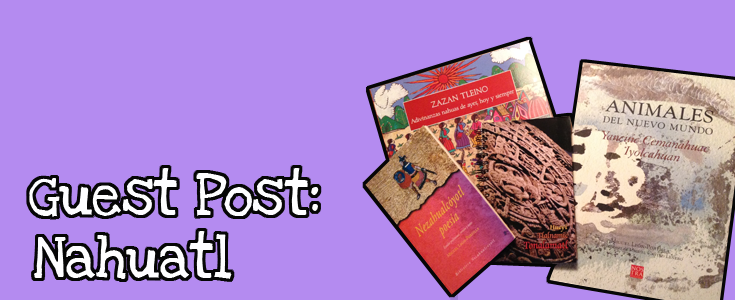January 19th, 2015
Guest Post: Learning Nahuatl
A couple of weeks ago, I was lucky enough to be featured on The Polyglotist, a language learning blog by Siskia, a Mexican language lover. I was absolutely delighted when she offered up a guest post on her experiences learning a rarer language, Nahuatl. Being really interested in the idea of focusing some attention of some lesser studied languages myself once my formal study is over, I found this post a darn good read. I hope you do too! Over to you Sis…
I’m pretty sure that if you’re reading Lindsay’s blog, it’s because you must like languages. So tell me, what are you thinking of studying this year? Spanish? French? Mandarin? Japanese?
How about Hawaiian? Yiddish? Welsh? Ainu? Telugu? Hausa? I hear Euskara’s hot property these days…
Believe it or not, as rare as these languages may sound to you, they’re all very much worth your time and consideration if you’re learning languages for the pleasure of understanding (or attempting to understand) foreign cultures. But wait! Instead of explaining why they’re so and so, I’d rather tell you a little about my own experience learning one, and why I think that learning a “rare language” is something everyone should try at least once.

In 2014, I decided to learn Nahuatl. Excluding Spanish, this is the most widely spoken of 67 (!!!) languages spoken in my native Mexico, and it’s gone through a remarkable revival period in the last few decades, in spite of having essentially gone underground while and after Mexico was under Spanish rule. Even nowadays, it’s spoken or known by over one million people between the US, Mexico, Guatemala and El Salvador! That’s six zeroes for you!
I decided to study this language for two reasons: first, my best friend speaks it quite decently and hearing him speak it sparked my interest. Second, I found it somewhat embarrassing that I didn’t know even the tiniest bit of a language that was considered the Latin of the Americas because of its huge influence and reach. You, dear reader, are probably using Nahuatlisms without even knowing so every time you open a chocolate bar (from xocolatl), or eat a tomato (from tomatl) or an avocado (from ahuacatl).
Now, if this is such an important language, finding where and how to study it should be a breeze, right?

Actually… not really. Latin of the Americas or not, Nahuatl remains a minority language and unlike most mayor languages it has no regulating body, so finding everything necessary for studying this language came as the result of exhaustive investigative work (an activity also known as “asking everyone AND their mother too”). As a matter of fact, this was a very enjoyable side-effect of my learning project. I expected to run into a wall while gathering learning resources, but asking around got me a lot of interesting information, opened lots of doors and made me at least one new friend!
Putting aside the hunting of textbooks, dictionaries, schools and such resources, I must admit that learning rare languages isn’t for everyone (particularly if it’s your second or third tongue). Not only is it hard to find learning resources, but encountering communities of people that speak it near your own location is oftentimes more of a chore than learning the language itself. It also doesn’t score you many “cool points” at parties to speak languages nobody knows of lest they consult Wikipedia on their smartphone. It requires a study strategy, a good deal of commitment, patience, and understanding of the fact that more often than not you’re going to be studying in a utterly analog fashion (no Duolingo for Maori yet!).

One, if not the biggest, of the rewards I reaped by studying Nahuatl for a year was a better understanding of my own culture. I realized that my everyday is soaked in a culture built by Mexico’s forefathers, and found new respect and love for this country (which sadly, is always hurting some way or another, but that’s a topic for another blog). In a way, learning Nahuatl was like taking a long, contemplative look inside my own house after I’d been travelling for what felt like forever. It was really an enriching experience for me, which is why I’d love for everyone to pick one minor language that’s always made them curious and start learning it. Don’t say “It would be so cool to learn…”, just go out, learn it! Somewhere in this broad world of ours, someone really appreciates your effort and interest in their (small, yet awesome) culture.
Not all countries have minor or rare languages, and I’m most definitely not saying you should learn them just because they’re part of your country’s identity or because they’re endangered and must be saved! (cue superhero theme), but because they’re just as interesting as any other language and carry with them the satisfaction of learning something unique, of knowing something not many do. Don’t be discouraged because you can’t find a course or textbook in the language you want to teach—use Google, go around bookshops, ask. But most importantly, have fun (and let me know if you are)!
If you’re interested, check out these websites aimed at the preservation and study of rare, endangered or minority languages—there are tons like these if you know where to look, but they’re a good start.
Wikitongues
Foreign Service Institute
Alliance for Endangered Languages
Be sure to visit Siskia’s blog, The Polyglotist for more interesting posts like this one. Do you have any experience learning Nahuatl or another rarer studied language? Which language takes your fancy? I’d love to know in the comments!
Learn more about indigenous languages with Language Stories
I actually spoke with Siskia a few years after she wrote this guest post as part of Language Stories. Watch the full seasons here and see the episode featuring Siskia below.








